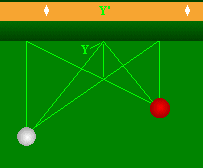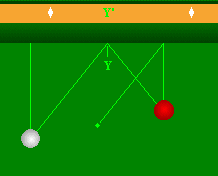A kick shot is when you drive the cue ball into the rail, and then into the object ball. Kick shots are something I have never been good at, but the need to do them seems to come up frequently. These are a couple of ways to calculate your shot. Heh, and I need to practice them.
 The "X Method": This method is in Willie Hoppe's book. You mentally draw the X in this diagram, from the cue ball to the "image" of the target ball on the rail, and from the target ball to the "image" of the cue ball on the rail. These two lines intersect somewhere between the two balls (and toward the rail from the two balls). Your target point Y is the image of this intersection point. Unless the two balls are a long distance apart, this method works very simply. Incidentally, geometry shows that the point Y, determined in this way, is the same exact point Y, determined above using similar triangles.
The "X Method": This method is in Willie Hoppe's book. You mentally draw the X in this diagram, from the cue ball to the "image" of the target ball on the rail, and from the target ball to the "image" of the cue ball on the rail. These two lines intersect somewhere between the two balls (and toward the rail from the two balls). Your target point Y is the image of this intersection point. Unless the two balls are a long distance apart, this method works very simply. Incidentally, geometry shows that the point Y, determined in this way, is the same exact point Y, determined above using similar triangles. The "Parallel Method": Yet another method, this one advocated by Dr. Cue, is to find the midpoint between the two balls. You can imagine drawing a line between the two balls, and finding its midpoint. Then aim along the line between this midpoint and the image of the object ball. The actual cue ball path (from the cue ball to point Y) will be parallel to this line. With a little practice, you can easily move your cue parallel to this line. This method works very well. It tends to be very inaccurate, if the balls are a long distance apart (because judging parallel lines is error prone). Incidentally, geometry shows that the cue ball path, determined in this way, goes to the same point Y, determined above using other methods.
The "Parallel Method": Yet another method, this one advocated by Dr. Cue, is to find the midpoint between the two balls. You can imagine drawing a line between the two balls, and finding its midpoint. Then aim along the line between this midpoint and the image of the object ball. The actual cue ball path (from the cue ball to point Y) will be parallel to this line. With a little practice, you can easily move your cue parallel to this line. This method works very well. It tends to be very inaccurate, if the balls are a long distance apart (because judging parallel lines is error prone). Incidentally, geometry shows that the cue ball path, determined in this way, goes to the same point Y, determined above using other methods.  The "Ghost Ball Method": This one works well if the angle is shallow (nearly parallel to the rail). Imagine a ghost ball off the table, about the same distance outside the rail that the target ball is inside the rail. If the angle is shallow, you may even be able to adjust your hit on the object ball in order to make it go where you want (like into a pocket), accurately. With this method, you can deal with the complications (which I cover below) in two different ways. You can deal with them in the same way that you do with the other methods. Or you can make your ghost ball farther outside the table, through point Y' (which I also describe later). Some adjustment has to be made, depending on how far the object ball is from the rail. Experiment, and let me know if you hit upon a good method. You can actually measure the position of the ghost ball, with your cue or fingers.
The "Ghost Ball Method": This one works well if the angle is shallow (nearly parallel to the rail). Imagine a ghost ball off the table, about the same distance outside the rail that the target ball is inside the rail. If the angle is shallow, you may even be able to adjust your hit on the object ball in order to make it go where you want (like into a pocket), accurately. With this method, you can deal with the complications (which I cover below) in two different ways. You can deal with them in the same way that you do with the other methods. Or you can make your ghost ball farther outside the table, through point Y' (which I also describe later). Some adjustment has to be made, depending on how far the object ball is from the rail. Experiment, and let me know if you hit upon a good method. You can actually measure the position of the ghost ball, with your cue or fingers.I don't recommend doing kick shots during your match unless you are in a bind and have no other choice. Keep these little secrets in your back pocket and pull em' out when you need to go for the win. They are tough shots --- but ah, such beauties when they roll in!
Good luck on the felt!








No comments:
Post a Comment